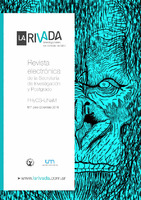El lado negro de La cinta blanca. Pensar el desprecio con Michael Haneke
The black side of The white ribbon. Thinking contempt with Michael Haneke
| dc.rights.license | Licencia de Creative Commons Reconocimiento-NoComercial-CompartirIgual 4.0 Internacional (CC BY-NC-SA 4.0) | |
| dc.contributor.illustrator | Sales Amengual, Francisco | |
| dc.creator | Steimbreger, Lautaro | |
| dc.creator | Spera, Ailén | |
| dc.date.accessioned | 2018-05-31T20:59:29Z | |
| dc.date.available | 2018-05-31T20:59:29Z | |
| dc.date.issued | 2016-12-01 | |
| dc.identifier.citation | Steimbreger, L., y Spera, A. (2016). El lado negro de La cinta blanca. Pensar el desprecio con Michael Haneke. La Rivada, investigaciones en ciencias sociales. Posadas (Misiones): UNaM. FHyCS; 4(7), 1-19. | |
| dc.identifier.issn | 2347-1085 | |
| dc.identifier.other | RLR-080 | |
| dc.identifier.uri | http://argos.fhycs.unam.edu.ar/handle/123456789/717 | |
| dc.identifier.uri | http://www.larivada.com.ar/index.php/ediciones-anteriores/31-numero-7-diciembre-2016/articulos-7/36-el-lado-negro-de-la-cinta-blanca | |
| dc.description | Fil: Steimbreger, Lautaro. Universidad Nacional del Comahue. Facultad de Ciencias de la Educación; Argentina. | es_AR |
| dc.description | Fil: Spera, Ailén. Universidad Nacional de Río Negro; Argentina. | es_AR |
| dc.description.abstract | El presente trabajo propone un análisis del film La cinta blanca (Haneke, 2009) centrado en el concepto de desprecio, un tipo de afecto triste que sienta sus bases en la desigualdad entre las personas. En el film la tensión entre el universo adulto masculino y el universo infanto-juvenil constituye el conflicto de la trama principal. Aun así el desprecio se manifiesta de diversas formas identificándose tres modalidades centrales: el desprecio hacia los niños y adolescentes (diferencia generacional), hacia las mujeres (diferencia de género) y hacia el niño discapacitado (diferencia biológica e intelectual). Asimismo, la narración y la puesta en escena reflejan las lógicas de las diversas afecciones vinculadas al desprecio. De este modo, el relato, constituido desde la ausencia y la negación, habilita la reflexión sobre el funcionamiento del desprecio y sus efectos sobre la sociedad. | es_AR |
| dc.description.abstract | The present paper proposes an analysis of the film “The white ribbon” (Haneke, 2009) centered in the concept of contempt, a type of sad affection based on inequality between people. In the film, the tension between the adult universe and the child and teenager universe is the conflict of the plot. Even so, the contempt is manifests in various ways, in this paper we will work three central modalities: the disregard for children and adolescents (generational difference), towards women (gender difference) and towards the disabled child (biological and intelectual difference). Also the storytelling and the mise-en-scene reflect the logics of the various affections related to the contempt. In this way, the narrative, constituted from absence and negation, enables reflection on the functioning of contempt and its effects on society. | en |
| dc.format | application/pdf | |
| dc.language.iso | spa | es_AR |
| dc.publisher | Universidad Nacional de Misiones. Facultad de Humanidades y Ciencias Sociales. Secretaría de Investigación y Posgrado | es_AR |
| dc.rights.uri | http://creativecommons.org/licenses/by-nc-sa/4.0/ | |
| dc.source | La Rivada, investigaciones en ciencias sociales (Misiones), 12-2016; 4(7): pp. 1-19 http://www.larivada.com.ar/ | |
| dc.subject | Afectos | es_AR |
| dc.subject | Desprecio | es_AR |
| dc.subject | Infancia | es_AR |
| dc.subject | Puesta en escena | es_AR |
| dc.subject | Affection | en |
| dc.subject | Contempt | en |
| dc.subject | Childhood | en |
| dc.subject | Mise-en-scene | en |
| dc.title | El lado negro de La cinta blanca. Pensar el desprecio con Michael Haneke | es_AR |
| dc.title | The black side of The white ribbon. Thinking contempt with Michael Haneke | en |
| dc.type | info:eu-repo/semantics/article | |
| dc.type | info:ar-repo/semantics/artículo | |
| dc.type | info:eu-repo/semantics/publishedVersion |
Files in this item
This item appears in the following Collection(s)
-
Revista La Rivada [229]
En esta colección se depositan los artículos publicados en la Revista digital La Rivada, una publicación semestral de la SINVyP-FHyCS-UNaM.




